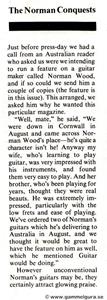An interesting guitar has passed the shop. Built by the wayward Englishman Norman Wood in 1977. I found an article about him in an English guitar magazine that I wrote about in a previous blog post. At the beginning of the magazine, there was a small text about him :-)
Well. The guitar had some problems. The top had a couple of cracks and the neck had folded a little into the sound hole with high string height as a result. It had been repaired earlier and a wide piece of mahogany had been glued into a crack behind the bridge. Either a USP mic had been fitted then, or it was original. It would in any case be replaced with a K&K pickup. The frets, in the form of round rods in nickel-silver steel, had possibly been crowned.
To access the inside and to fix the sunken top around the sound hole, I opened the bottom. That was a bit tricky as the binding around the bottom was not a solid wood molding, but two layers of thin maple veneer. Mahogany is also troublesome as it has a texture similar to crispbread, usually it is difficult to get loose glued bottoms without some damage. This time it went really well. I milled away the old binding, so I could see the glue joint. The glue was probably carpenter's glue and although it sat hard, it reacted to heat and water.
All the braces inside were in mahogany (top, side and bottom were also in the same wood), it seems that he did not like spruce! The bracing was different with a slight fan-bracing below the sound hole with a bridge plate in maple. The sparse braces was probably the main reason why the top had cracked, you should tie the top across the fibers with braces and not leave large surfaces without reinforcement.
I reinforced the neck block, which was a bit weak, with some extra pieces of wood and changed the top braces and reinforcements next to the sound hole to an A frame. I also glued a few strips of spruce across the fibers on the top to avoid new cracks.
The neck was pulled loose, which proved unnecessary, as I only had to glue it back to get the correct string height. The dove tail in the neck foot was completely straight, which meant that you had to pull it up all the way before it loosened. The fretboard was thick and in a greenish very hard wood (Lignum vitae?) with a thin rosewood veneer on top. The neck was made of solid rosewood, the head mahogany.
The frets / bars at the end of the fretboard loosened some of the heat as I heated the neck. I had to heat them tighten them properly to bring them down to the right height again. If you want to loosen the neck of one of these, you should only heat in the joint itself (heat the spatula on an iron) and not the frets / bars.
I obtained maple veneer in a roll and cut strips to the size of the bindings around the bottom. I needed three layers to build up the binding. I milled the trench and covered it with a plastic wrap, then glued all three layers together with hot hide glue in the trench to give the binding its shape. The plastic wrap allowed me to loosen the glued binding, make it smoother and finally glue the binding in place. This is a way to make a binding without having to heat and shape solid wood. Not as good and about the same amount of work as using solid wood bindings.
I had to crown the frets on the round rods, I then put on Newtone Masterclass 0.11 steel strings. The frets in the form of round bars worked, but the extra job with that solution is hardly worth the trouble. Possibly it can be good on a Django guitar where you want the hardest possible attack and maximum volume, the large mass in the bands compared to regular bands should give better attack when playing with a thick pitch.
An odd detail was that the string pins leaned forward (!) In the string pin holes. I haven't yet figured out why.
The back was probably most strange. No braces were needed, but it was also rather "dead". Almost no difference in the sound whether you let the bottom rest against the stomach or not.
To make the new binding and the repairs blend in to the old shiny surface, I put on some True Oil.
It is a large guitar, 105 cm long, the top 42 cm at the widest place and the rim is almost 10 cm wide. The bulge on the back is about 2 cm high. The case that came with the guitar (in the brown 1970s hard plastic) was specially made with an extra bulge for the bottom :-)
After three days of vibration, it opened up and actually sounds really good. It is Comfortable to play on. It sounds a bit like a really good archtop guitar, not excessive bass, but hard attack and a good volume. But at the same time, not much of the warm sound from a fixed bridge. The very thin and flat neck was a bit square, but worked well to play on. The intonation when playing cowboy chords is not the best, but that's what you get without a nut intonation.
There might not be much to learn from this oddity, but it was fun to see something different!














